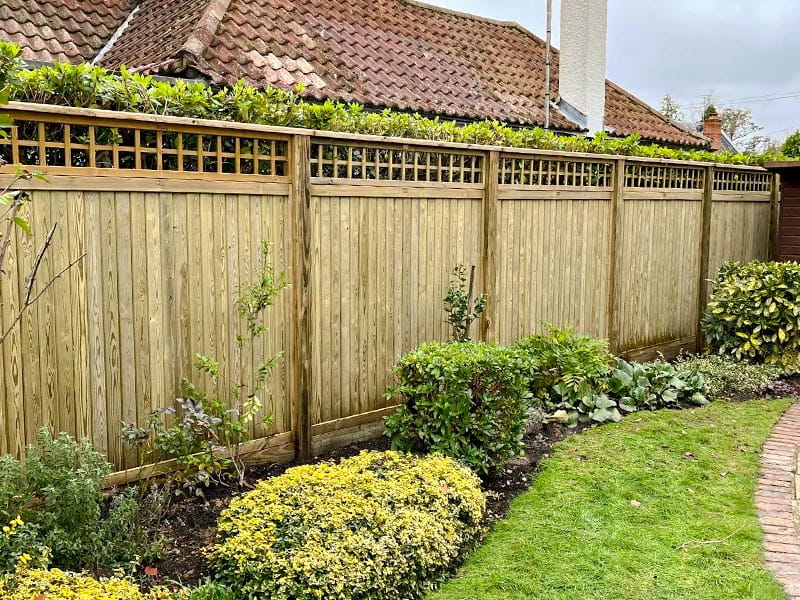12/06/2025 12:00 AM
Rattling fence panels are not just an annoyance – they can be a sign that your fence is not secure, or isn’t performing as it should.
Whether it's disrupting your sleep during a windy night or simply creating an irritating background noise in your garden, a rattling fence is something most homeowners want to fix quickly. But why do fence panels rattle in the first place, and what can you do to stop it?
What Causes Fence Panels to Rattle?
There are several common reasons:
1. Concrete posts
Using concrete posts is the most common reason for your fence panels to rattle. Why? Because you can’t secure the fence to the post. You can’t drill into concrete without affecting the integrity of the structure. In a fence run, panels sit in the slots within the posts. There will usually be space between the panel and the posts, which with no secure fixing, creates space for the panel to move and therefore hit against the slotted post repeatedly. Pieces of timber can be wedged between the fence and the post but this is only a temporary solution.

2. Loose Fit Between Panel and Posts
The most frequent cause of rattling is when fence panels haven’t been securely fixed to the posts, whatever material they are made from. Many traditional panels simply slot into concrete or timber slotted posts. While this method is quick and convenient, it can leave too much room for movement, especially in windy conditions.
3. Timber Shrinkage
Timber is a natural material and can shrink slightly over time, particularly in dry or hot weather. If your fence was installed tightly in winter due to excess moisture, it might loosen slightly by summer.
4. Inadequate Fixings
Panels that are only held in place by gravity or basic fixings may not be secure enough to resist strong winds. Over time, nails or screws can loosen, allowing movement.
5. Poor-Quality Panels
Lightweight or low-grade fence panels are more susceptible to flexing and rattling in the wind, especially if they’re not reinforced.
How to Stop Fence Panels Rattling
Now for the good news: it’s usually a straightforward fix.
- Use wooden posts
Using wooden posts can eliminate rattling altogether because, unlike slotted concrete posts, they allow fence panels to be securely screwed directly into the post, creating a solid, fixed connection. This method removes any potential for movement caused by gaps or loose fitting, which are common in systems where panels simply slot in and rely on gravity. With timber posts, the panel becomes part of a rigid structure, significantly improving overall stability and reducing the risk of noise in windy conditions. This makes timber posts the preferred choice for a quieter, more secure fencing solution.

A secure fixing reduces strain on the fence posts by preventing the panel from constantly shifting within the slot. By eliminating this movement, the entire structure remains more stable, which not only protects the posts from unnecessary wear but also enhances the overall integrity of the fence and extends its lifespan.
Did you know all our wooden and metal fence posts are guaranteed for 25 years against rot and insect attack.
2. Add Foam/Rubber Buffers or wedges
For minor movement, you can place weather-resistant foam or rubber strips between the panel and the post to cushion the gap and prevent rattling. Another option is timber wedges. Both are more of a temporary solution but can work well in sheltered areas.
3. Inspect and Tighten Existing Fixings
If your fence has been up for a few years, it’s worth checking all screws, nails, or brackets. Tighten anything that’s come loose and replace rusted or worn fixings.

4. Consider Gravel Boards
Gravel boards help stabilise the base of the fence and reduce movement. They also protect panels from ground moisture, which helps extend their lifespan.
Choose fence panels suited to wind prone areas
Semi-solid fence panels are an excellent choice for exposed or windy areas, as they allow wind to pass through rather than resist it entirely. This reduces the pressure placed on both the panels and the posts, helping to prevent damage during storms or prolonged periods of high winds. By minimising wind resistance, these fence panels reduce the overall strain on the fence structure, which can significantly improve durability and reduce the risk of panels becoming loose, posts leaning, or the fence failing prematurely.

Choose kit form fencing
Instead of posts and panels, you could choose traditional/kit form fencing which is built from posts, rails, and pales on site, ensuring a perfect fit and leaving no room for rattling due to the secure way it is built.

Long-Term Prevention: Invest in a Quality Fence
Ultimately, the best way to avoid rattling fence panels is to invest in high quality wooden fencing and posts from the outset. At Jacksons Fencing, our fence panels are heavily framed, made from premium pressure-treated timber, and designed to be permanently fixed to posts. Combined with our 25 year guarantee, this means you get peace of mind and a rattle-free garden fence for decades to come.
Related content
Debating using concrete fence posts? Read our blog on the pros and cons.